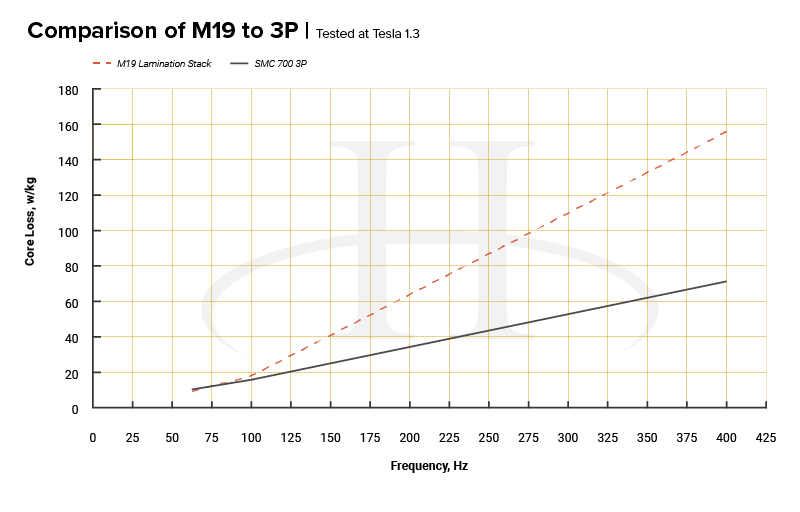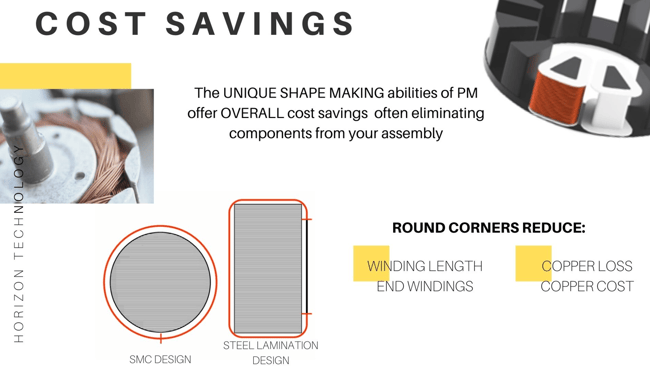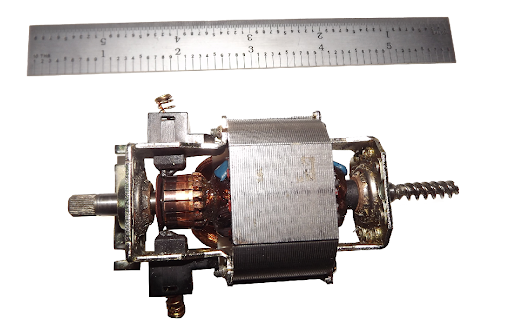When it comes to electric motor materials, there’s not much to choose from.
The two big contenders right now are electrical steel laminations and soft magnetic composites (SMCs). While they both have their benefits, they also have some problems, including:
- Core losses
- Shape-making limitations
- Overheating
The motor materials of tomorrow? That’s another story. But before we get to the most efficient electric motor design, let’s review where magnetic motor materials fall short today.
Core Losses in Electric Motor Materials
All electric motor materials experience some kind of energy loss. It’s an intrinsic and inevitable part of the nature of AC fields and their interaction with magnetic materials. But some materials yield more to core losses than others.
The equation for core loss of SMC materials is calculated as follows:

Ptot = Kh * f* B1.75 + Kep * f 2 * B2 + (B2 * f 2 * d) / (1. 8 * ρ * resistivity * 1000): in which,
- Kh = Hysteresis loss coefficient = 0.063 for Somaloy 700 3P
- Kep = Eddy current coefficient = 0.000027 for Somaloy 700 3P
- d = Smallest cross section of component [mm]
- f = Frequency [Hz]
- B = Field strength [T]
- ρ = Density [g/cm3]
- resistivity in micro ohm meter
- Ptot = total core loss in watts / kg
The utility of this equation is the ability to predict and model the performance of an SMC material regardless of operation condition. Unlike the corresponding steel laminations where the same benefits aren’t available.
The Solution for Core Losses
The need for higher efficiency and performance is pushing people toward reducing core losses (heat buildup). One way to significantly reduce losses is to consider the material.
[SMC v. lamination core loss chart]
SMC stators used in motors operating above 60-100Hz see a significant reduction in core losses, whereas laminations see a drastic increase in losses at higher frequencies. Back to our heat example: The motor will run cooler and require a less-robust cooling fan to keep the motor cool and not burn the motor windings.
Shape-Making Capabilities of Electric Motor Materials
Shape-making is another limitation of laminations.
As the word implies, laminations are made of many thin layers of metal stacked on top of each other to form a part. However, laminations use 2D magnetic flux so they don’t lose too much magnetism in the direction perpendicular to the laminate. An example? Radial flux motors.
Powder metal operates like a cake batter; you set a mold and pour the powder into the mold. Advanced compaction technologies allow manufacturers to produce single-piece parts with far more complex geometries than laminations ever could.
The Solution for Net-Shaped Parts
Because SMCs start out as a powder, they create a 3D magnetic flux path, which allows for more unique shape-making capabilities. PM -- plus SMCs -- allows you to take a multi-piece assembly and turn it into a single part.
SMC parts combine their improved magnetic properties with the unique shape-making capabilities of powder metallurgy to make a shape-specific, efficient part.
This single part lowers the core losses and creates the potential to reduce component cost.

Heat Reduction of Electric Motor Materials
The final problem to address is reducing heat within the motor.
Have you ever touched a running electric motor? The first thing you’ll notice is the motor is hot. This heat is a result of the hysteresis and eddy current losses generated in the AC field.
A good example is the heat generated in a small appliance motor. In only 8 minutes of run time, the motor temperature increased from about 80° F to about 140° F. This temperature rise is about 11 W/kg -- higher than what we might see when using an SMC component.
For many of today’s conventional motors, small fans are the solution to overheating.

Almost every appliance with a motor has a fan, but that fan consumes valuable energy. Some engineers have moved toward water cooling to keep motors at a reasonable temperature, but those types of systems are costly.
So how do we solve this problem? There are a few ways.
The Solution for Heat Reduction
The solution for overheating isn’t nearly as difficult as it might seem.
SMC stators in motors reduce the amount of energy needed to run the motors, which decreases the amount of energy leaving the motor as heat.
Since there’s less heat, we can reduce the number and/or size of the fans needed to cool the motor. Less energy diverted to the fans = more energy to run the motor, creating a more efficient system overall.
Continuing to play off this ripple effect of SMC stators, having fewer or smaller fans reduces the weight of the motor assembly. This can be a small secondary plus for stationary appliances, but a potentially large plus for automobiles and other e-transport.
How SMCs Can Make Electric Motors Better
So, it seems that soft magnetic composites have come out on top as the future electric motor material.
In addition to the net-shaping qualities, heat reduction, and reduced core losses capable with SMCs, there are even more benefits. And these benefits translate directly to electric motor design.
- Weight reduction: The shape-making capabilities of SMCs in powder metal can decrease individual part weight, opening up the potential to reduce the overall weight of an electric motor assembly.
- Simple design: Innovative electric motor stator design coupled with SMC components simplifies the stator winding scheme and, in turn, the winding machines.
- Reduced copper loading: Using a more simple winding scheme will reduce the amount of copper used for the stator and will maximize the electric circuit.
SMC materials are a cost-efficient way to expand electrification methods, making e-transport and micromobility more affordable for the end customer.
Plus, SMC technology isn't restricted to stator coil assemblies, either. It's also a viable option for other electric motor components as well:
Watch the video on Youtube here.
Innovative PM technologies aren’t restricted to improving electric motor efficiency. They’re also beneficial for other industries:
- HVAC
- Sustainable energy
- Aerospace
- Transportation
- Power tools
- Firearms
- Lawn and garden
- Appliances
- And the list goes on!
PM Design for Power and Efficiency
Have questions about how powder metallurgy and soft magnetic composites can take your application to the next level? Our engineers love talking about increasing efficiency -- drop them a line!
Coming soon: How PM Is Driving the Future of Electric Motor Materials with PM Rotors



